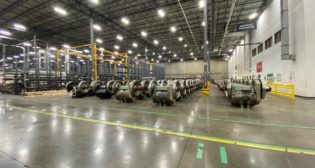
Norfolk Southern unveils first publicly funded, emissions-friendly locomotives
Written by William C. Vantuono, Editor-in-ChiefThe first two GP33ECOs sport a distinctive paint scheme that reflects their environmentally friendly mission. After in-service testing in the Altoona area, they will be permanently assigned to their respective grant award areas of Chicago and Atlanta.
Funding for the 15 locomotives to be used in the Chicago area was awarded by the Chicago Metropolitan Agency, sponsored by the Illinois Environmental Protection Agency, and administered by the Illinois Department of Transportation.
Funding for the 10 locomotives to be used in Georgia (on Norfolk Southern’s Atlanta Terminal) was awarded by the Georgia Department of Natural Resources Environmental Protection Division.
The GP33ECOs are rebuilt ex-Southern Railway “high hood” GP50s re-powered with new, 12-cylinder, 3,000-hp 12N-710G3B-T3 Electro-Motive Diesel prime movers that meet EPA Tier 3 emissions standards. They’re equipped with Admiral Cabs and EM2000 microprocessors. Thirteen of the 25 units will be mated to RP-4MC slugs. All of Atlanta’s units will be mother-slug sets while three of Chicago’s will be slug sets.
The Admiral Cab is an NS-designed narrow-nose, low-hood cab that meets current FRA crashworthiness standards. NS contracts with Curry Supply Co. of Curryville, Pa., to build the Admiral Cab, which retains the basic look and feel of a standard EMD cab, the main exceptions being angled center windows, a raised numberboard section, and under-floor air conditioning. The cab’s nose section is constructed from one-inch-thick steel vs. the quarter-inch steel of the original EMD cab, and weighs 12,500 pounds compared to the 3,500 pounds of the original. It is delivered to Juniata in one piece.
Unlike a traditional cab, the front windows slope inward from the top down, intended to cut glare, similar to windshields on Navy vessels. The design idea came from retired U.S. Navy Adm. Joseph Paul Reason, who served on NS’s board of directors. Reason was Commander in Chief, United States Atlantic Fleet from 1996 to 1999. Earlier in his career, as a commander, he was naval aide to President Jimmy Carter, from December 1976 to June 1979. In 1996, Reason became the first African-American officer in the United States Navy to become a four-star admiral.



